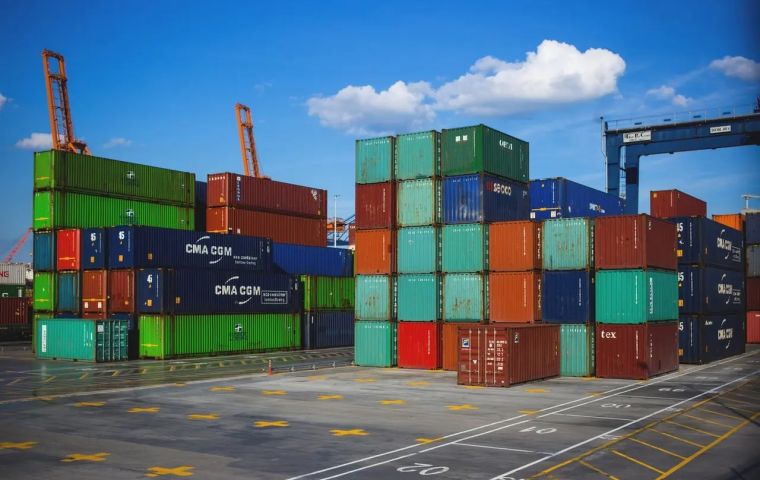MercoPress. South Atlantic News Agency
Latin America exports in 2023 contracted 2,2%, and prospects for this year are uncertain, IDB report
 Export performance deteriorated throughout most of the region. South America and the Caribbean were the sub regions hit hardest by the fall in commodity prices
Export performance deteriorated throughout most of the region. South America and the Caribbean were the sub regions hit hardest by the fall in commodity prices The value of exports from Latin America and the Caribbean contracted by 2.2% in 2023 after having grown by 17.0% in 2022, a new release from the Inter-American Development Bank (IDB) reports.
Although the rate of the decline slowed in the last quarter of 2023, the outlook remains skewed to the downside. Early indications are that the region’s exports would not change in trend in the first half of 2024.
The decline in the region’s exports is due to a fall in export prices and a slowdown in volumes, according to the latest edition of Trade Trends Estimates for Latin America and the Caribbeana, which presents cumulative data for the past year.
Paolo Giordano, Principal Economist at the IDB’s Integration and Trade Sector, said that “after the two years of growth that came with the Covid-19 recovery, exports from Latin America and the Caribbean entered a contractionary phase in 2023.”
“The balance of risks suggests that the trade contraction will ease in the coming months, although a great deal of uncertainty still surrounds the timing and intensity of a potential recovery,” added Giordano.
The export performance deteriorated throughout most of the region. South America and the Caribbean were the sub regions hit hardest by the fall in commodity prices. In contrast, exports from Mesoamerica, which includes Mexico and Central America, grew driven by Mexico’s shipments to the United States. Sales from Central America were flat.
Countries which experienced the highest contraction include Argentina, 21,3%, Bolivia, 21% and Uruguay, 19%. This was mainly to extraordinary conditions which cut into harvests.
The IDB report found that the average prices of the main Latin American and Caribbean export commodities were lower in 2023 than in 2022. However, most prices stabilized over the year and are still at historically high levels. The price of oil (-16.7%), soybeans (-8.6%), copper (-3.6%), and iron (-0.9%) decreased year-on-year. Sugar prices were an exception, rising by 27.7% year-on-year.
The report also forecasts that “commodity prices are expected to be highly volatile with a downward trend in the current context of weak demand.” However, new economic, political, or climate-related shocks could alter this outlook.
The performance by region suggests that in South America, exports are estimated to have decreased by 5.3% in 2023 after growing by 16.4% in 2022. Falling commodity prices accounted for most of the subregion’s performance, while volumes are estimated to have increased by 1.7%.
Exports from Mesoamerica increased by 2.6% in 2023 after growing by 16.1% on average in 2022. There was a 2.9% increase in exports from Mexico in 2023. In contrast, sales from Central America were flat (0%).
Exports from the Caribbean countries contracted at an estimated rate of 31.9% in 2023 after growing by 72.1% in 2022 driven by the energy sector (oil and gas).
The region’s total imports are estimated to have fallen by 5.9% in 2023 after increasing by 20.9% in 2022.
Finally IDB reports that prospects for a reversal of this trend in the next six months are limited, given the context of low global economic growth, persistent inflation, restrictive monetary policies, and growing geopolitical conflicts. Meanwhile, weak demand would limit upward pressure on commodity prices, barring further escalation of conflicts in the Middle East and extreme weather events affecting the supply of oil and agricultural products, respectively.
Global economic growth is expected to remain weak in 2024 due to continued high interest rates, particularly in advanced economies, while inflation returns to target levels. This would limit access to credit, especially for developing countries. Despite some recent signs of expansion, the growth slowdown in China would particularly impact real demand for LAC exports.
In this environment where downside risks predominate, the war in Ukraine continues and new armed conflicts have arisen in the Middle East, disrupting global supply chains, increasing transportation 11
costs, and potentially leading to further increases in commodity prices, especially oil. This may have a negative impact on inflation and global activity, which will indirectly affect the region’s real exports.




Top Comments
Disclaimer & comment rulesCommenting for this story is now closed.
If you have a Facebook account, become a fan and comment on our Facebook Page!